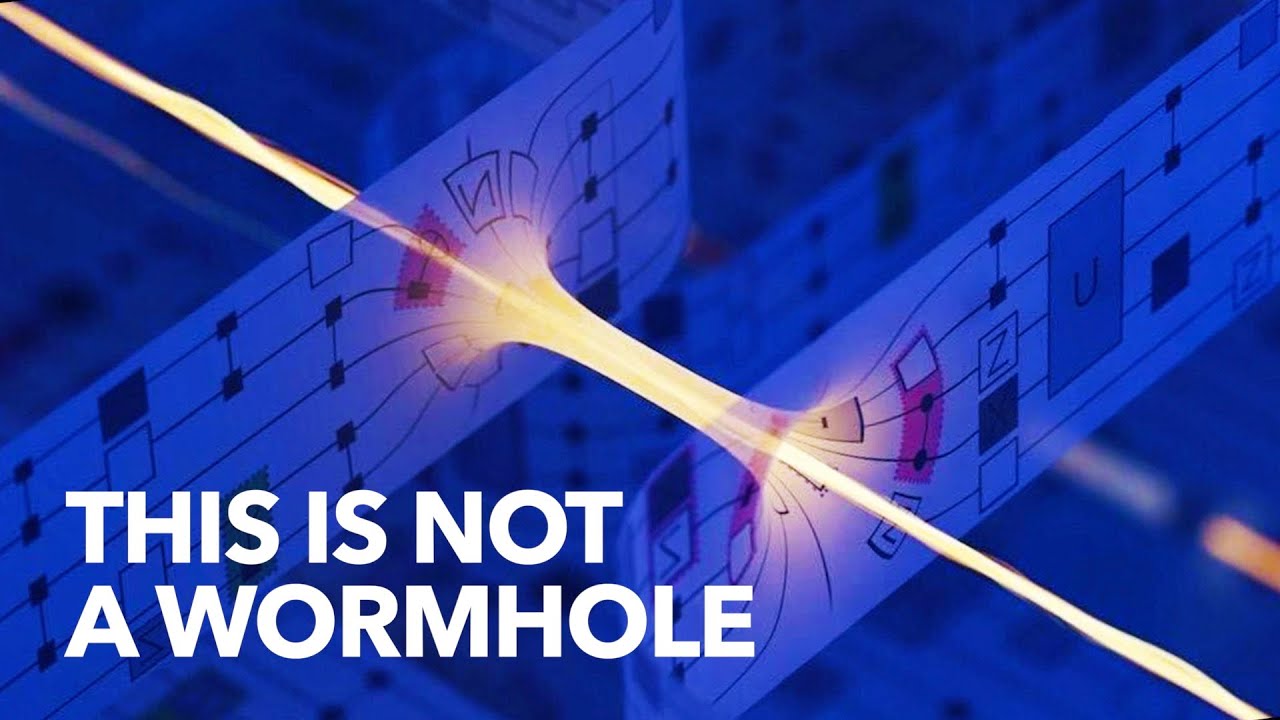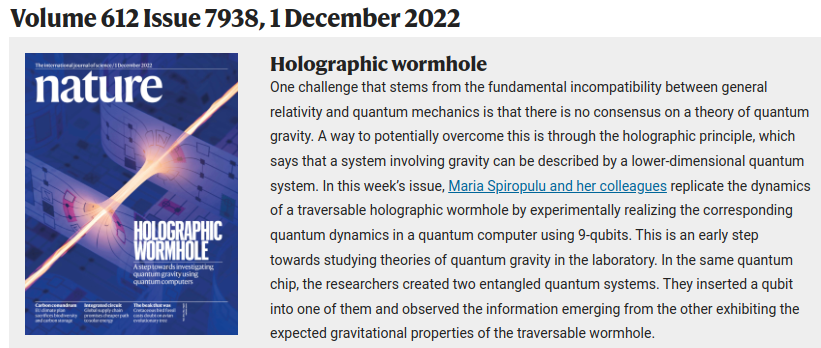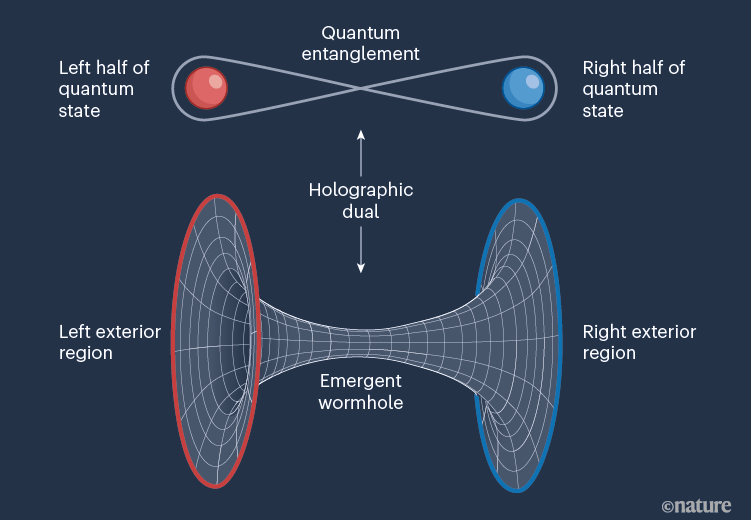FYI
https://www.nature.com/articles/d41586-022-03832-z
A holographic wormhole traversed in a quantum computer
30 November 2022
A system of nine quantum bits has been used to simulate a state known as a holographic wormhole, a concept that features in attempts to reconcile quantum mechanics with the general theory of relativity.
The holographic principle is a guide in our quest to understand how to combine the two most celebrated theories of modern physics — quantum mechanics and general relativity. According to this principle, theories that include both quantum mechanics and gravity can be exactly equivalent to other theories that involve quantum mechanics but not gravity. Such an alternative description is known as a dual, and has fewer dimensions than its gravitational counterpart — much like how a hologram projected on a 2D surface displays a 3D image. Writing in Nature, Jafferis et al. 1 report using a quantum computer to generate a state that mimics a hologram whose dual is an entity known as a wormhole, and then evolving this state to simulate a message traversing the wormhole.
The idea of a wormhole dates back to 1935, when Albert Einstein and his collaborator, Nathan Rosen, studied black holes in the context of Einstein’s general theory of relativity2. Every black hole has both an interior region, from which nothing can escape, and an exterior region, from where escape is still possible. The two regions are demarcated by a surface called the event horizon. What Einstein and Rosen noticed is that, in a mathematical idealization of a black hole, there is actually not one exterior region, but two, and they are connected through a kind of wormhole now known as an Einstein–Rosen bridge.
But this is no ordinary bridge. On the one hand, in the version studied by Einstein and Rosen (and unlike that considered by Jafferis and colleagues), it is impossible to travel through the wormhole from one exterior region to the other — the wormhole cannot be traversed. On the other hand, if someone jumps into the interior region of the black hole from one exterior region, it is possible for them to meet someone jumping in from the other exterior region, but their time together would be brief, because by jumping in they’d be doomed to certain death. The bridge cannot be crossed, but people from opposite ends can briefly meet in the middle.
In the same year, Einstein and Rosen wrote another paper, this time in collaboration with Boris Podolsky3. The trio’s paper examined quantum mechanics (without gravity), and identified the phenomenon now known as quantum entanglement, which Einstein described as “spooky action at a distance”. Entanglement is a property of quantum systems that allows them to be linked through a strange, non-classical pattern of correlations, even when they are separated by extremely long distances. This pattern of correlations is a signature of quantum mechanics, because it cannot be reproduced by any classical process that doesn’t involve faster-than-light communication. However, quantum entanglement cannot itself be used to send messages faster than light, and so although entanglement might indeed seem spooky, we now understand that it’s not really action at a distance.
At the time, these two ideas — wormholes and entanglement — were considered to be entirely separate. But since then, the relationship between them has become increasingly central to our understanding of quantum gravity4. The two exterior regions of the black hole are connected by a huge amount of quantum entanglement, and the inability to travel from one exterior region to another is understood to be ‘holographically dual’ to the inability to use entanglement to send messages faster than light speed (Fig. 1).
Figure 1 | An emergent wormhole in a quantum computer. Quantum systems can display a non-classical pattern of correlations, even when the parts are separated by long distances, because of a property known as quantum entanglement. The holographic principle tells us that some non-gravitational quantum states have an alternative description in terms of higher-dimensional gravitational states. This alternative description is known as a holographic dual. Jafferis et al.1 generated a certain highly entangled quantum state between the two halves of a quantum computer, chosen so that its holographic dual is an entity known as an ‘emergent wormhole’ stretched between two exterior regions. They then simulated a message traversing this wormhole.
Later, the connection between wormholes and entanglement was taken a step further, with a thought experiment that considered what would happen if the two exterior regions could be made to interact5,6. Such an interaction could be used to send a message from one exterior region to the other, and it was shown that this would have an elegant holographic dual. In the dual gravitational description, the reason that the message passes from one exterior region to the other is that the interaction causes the wormhole to open up and become briefly traversable. The message simply passes through the wormhole. This doesn’t permit faster-than-light communication through the wormhole, because the wormhole can be opened only by the interaction, and it is possible to make the two sides interact only if there is already a way of connecting the two exteriors that takes less time than traversing the wormhole5–7.
A modified version of this thought experiment was later proposed — one that could actually be performed as an experiment on a quantum computer8,9. The first step is to generate a particular entangled state between the two halves of a quantum computer, chosen to be the holographic dual of two exterior regions connected by an emergent wormhole. Next, we insert the message on one side, wait for it to get scrambled, and then briefly couple the two sides. After a short delay, the message unscrambles on the other side. This is the dual to the message traversing the wormhole. Jafferis et al. report performing this simulation on a small quantum system comprising nine quantum bits (qubits).
We should stress that, in this simulation, the ‘gravity’ experienced by the message traversing the wormhole is the emergent gravity in the holographic description, and is therefore entirely unrelated to the gravitational forces that moor the quantum computer to Earth. This means, for example, that there is no risk of the quantum computer being swallowed by the black hole. We also stress that it is possible to predict the evolution of the state of the quantum computer simply by using the normal rules of non-gravitational quantum mechanics, without any reference to the holographic gravitational dual.
But what the holographic gravitational description offers is a simple explanation for a complicated phenomenon. In the non-gravitational description, the appearance of the unscrambled message on the other side is an unambiguous prediction of quantum mechanics, but it is nonetheless somewhat mysterious. The surprise is not that the message made it across in some form, but that it made it across unscrambled. However, this is easily understood from the gravitational description: the message arrives unscrambled on the other side because it has traversed the wormhole. This protocol, if successful, thus uses a quantum computer to exhibit a phenomenon for which the simplest explanation invokes the idea of an emergent wormhole.
The holographic duality is sharpest in systems that contain a huge number of degrees of freedom, but state-of-the-art quantum computers have such high error rates that they can simulate only a modest number of qubits. With nine qubits in total, Jafferis and colleagues’ quantum system is so small that the holographic wormhole is of low resolution. Furthermore, because nine qubits can be easily simulated on a classical computer, the results of this experiment cannot teach us anything that could not be learnt from a classical computation, and will not teach us anything new about quantum gravity. Nevertheless, Jafferis and colleagues’ experiment is a proof of principle that sets the stage for further developments.
The technology of quantum computers is advancing rapidly, and other laboratories are already trying to implement holographic traversable wormholes on different platforms from that used by these authors10. The past decade has seen an explosion of ideas connecting black holes with quantum computing — a dialogue that holds great potential for stimulating ideas in both fields. To see this, we need look no further than the original thought experiment from five years ago6: although the authors could have invented their protocol by thinking about quantum mechanics alone, in fact, the protocol was discovered only after taking inspiration from black holes. We might hope that, in the future, quantum-communication techniques might be invented that are too difficult to analyse by conventional means, but which use the holographic duality as a powerful tool for analysis and discovery.


